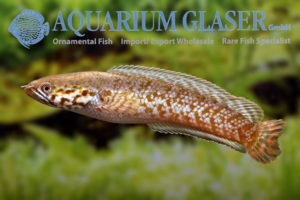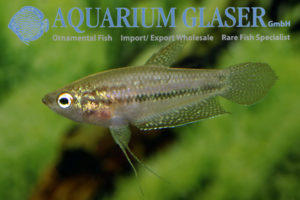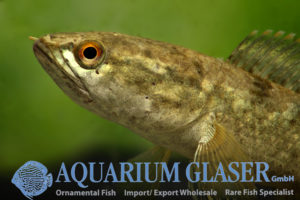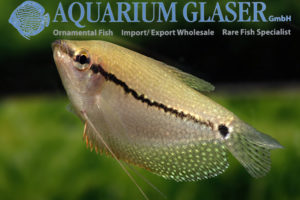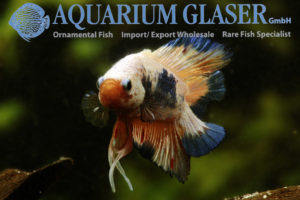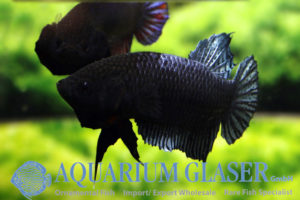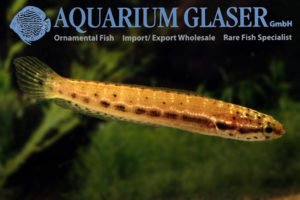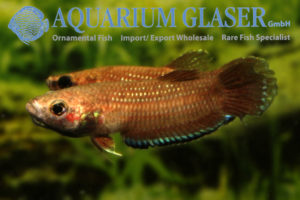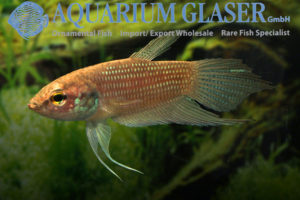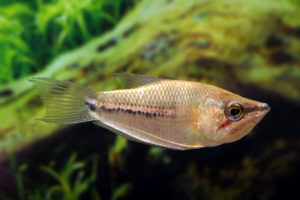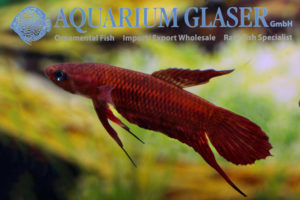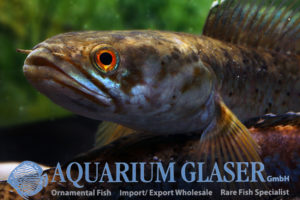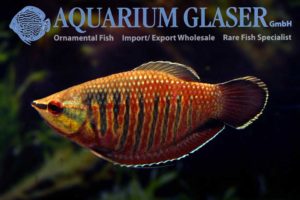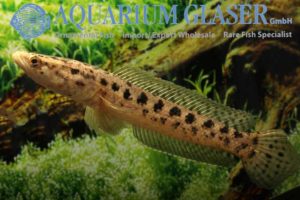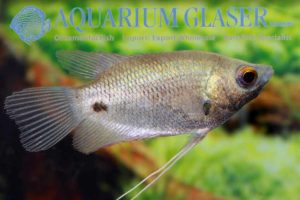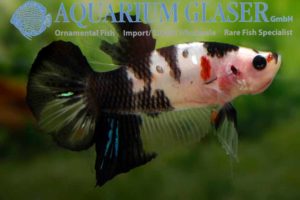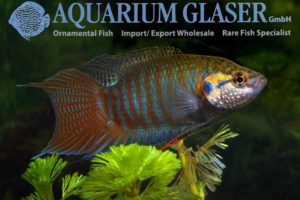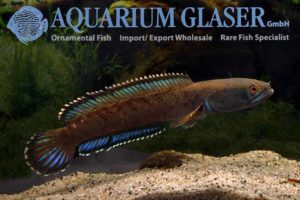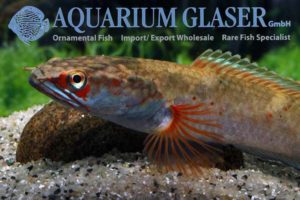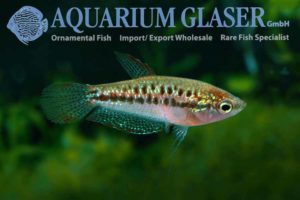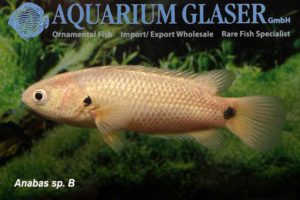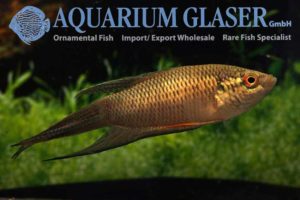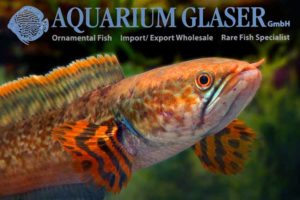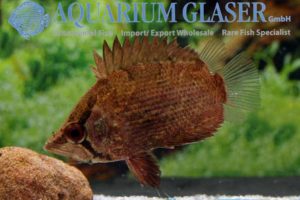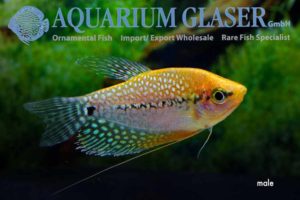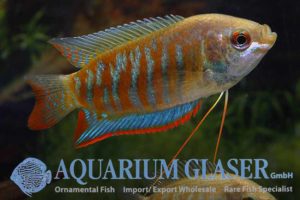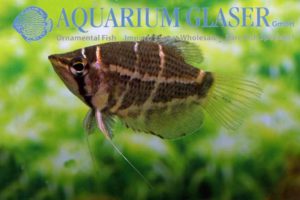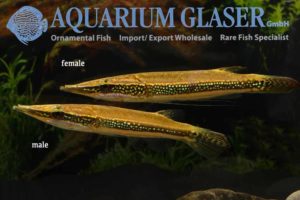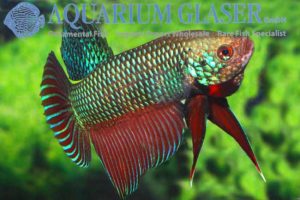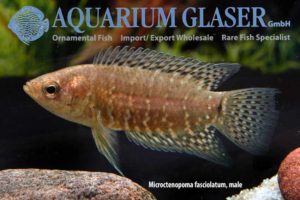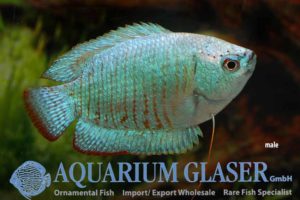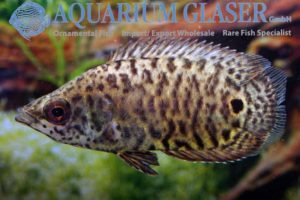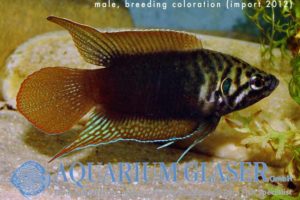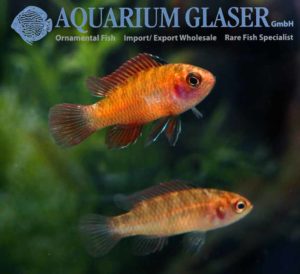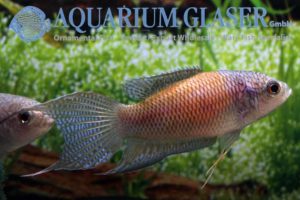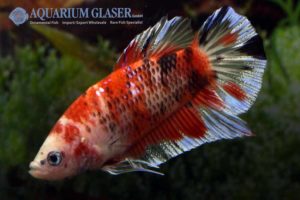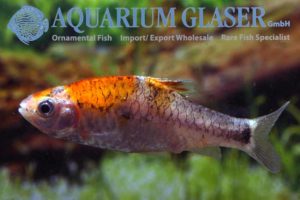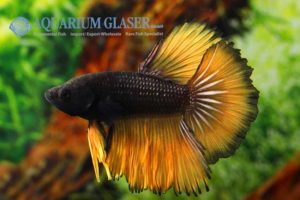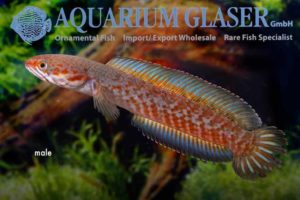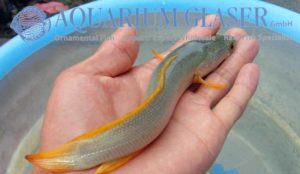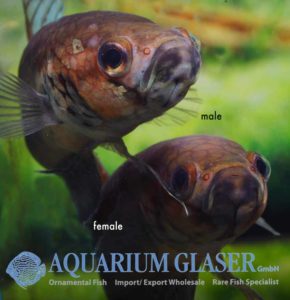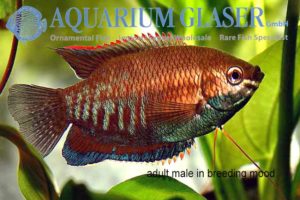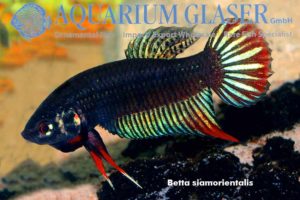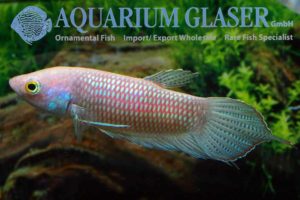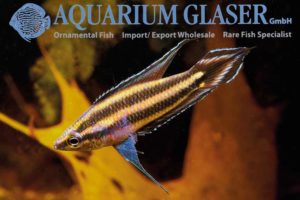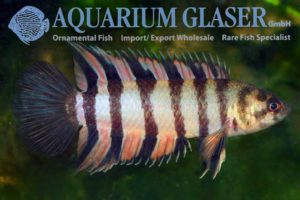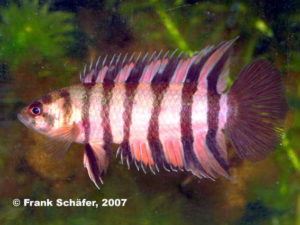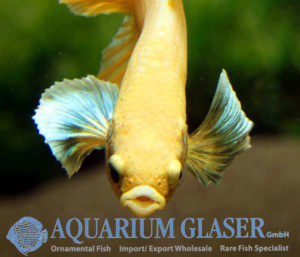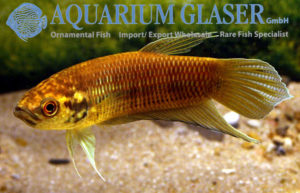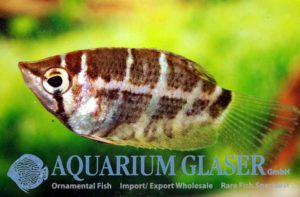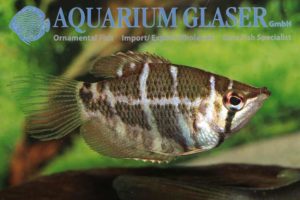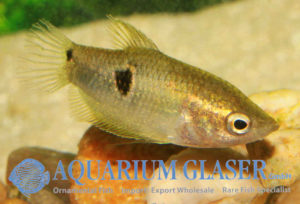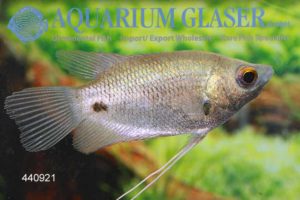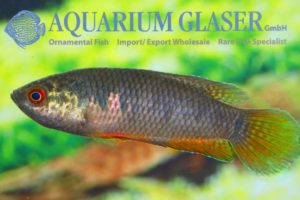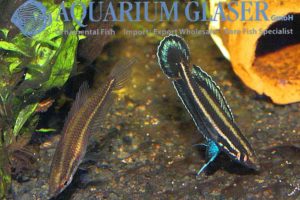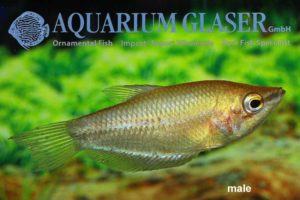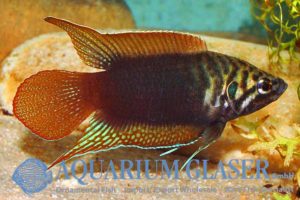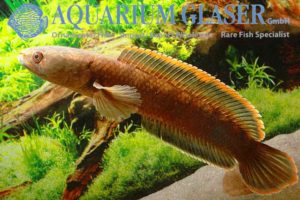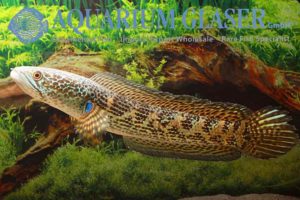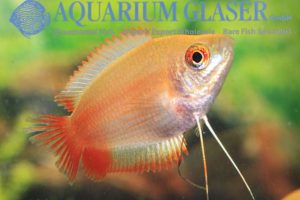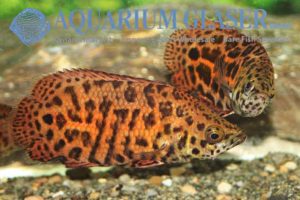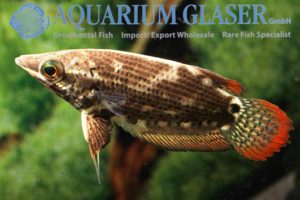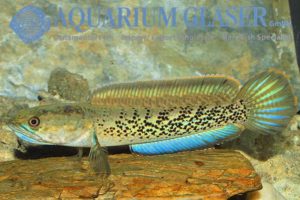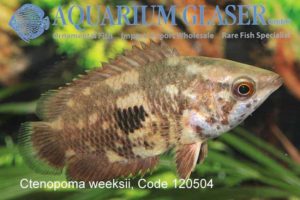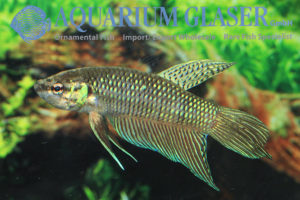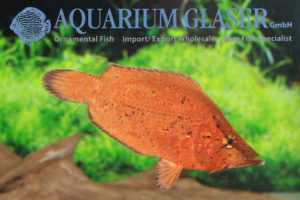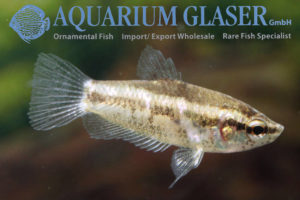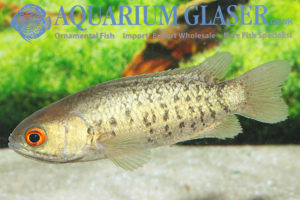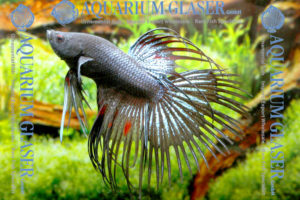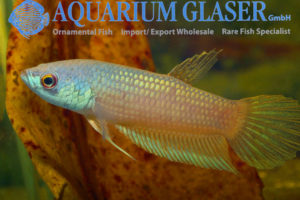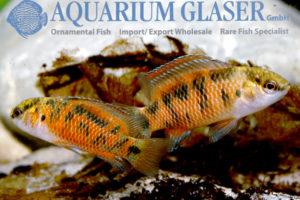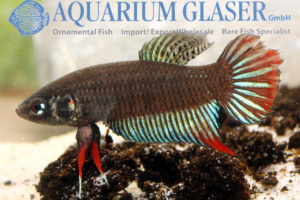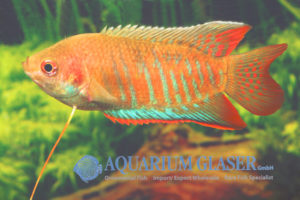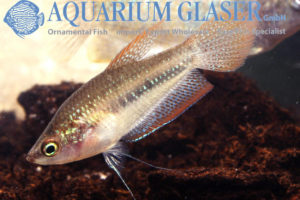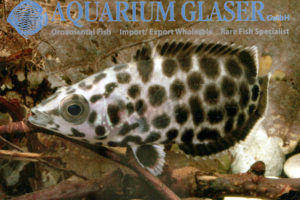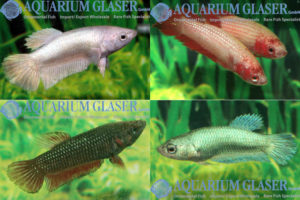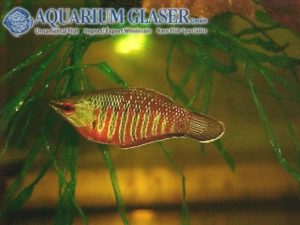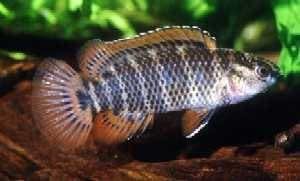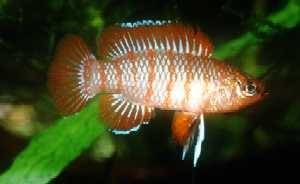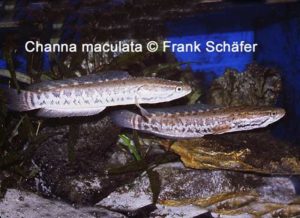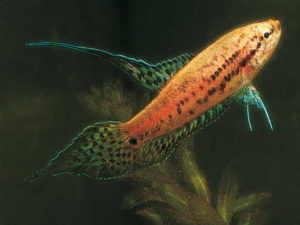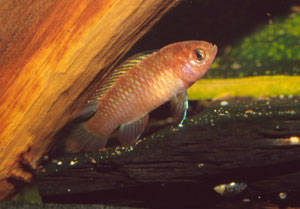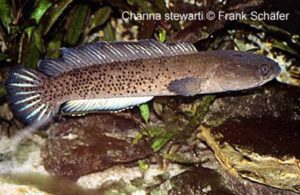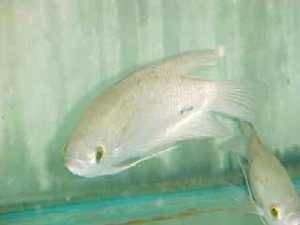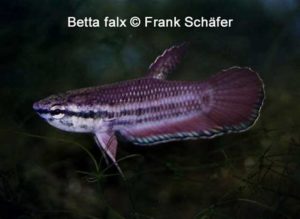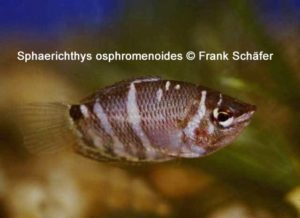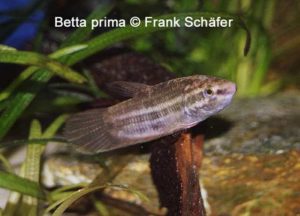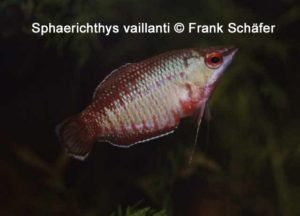Currently is the import season for one of the most beautiful species of snakehead, the rainbow snakehead (Channa bleheri) from the state of Assam in India. The species is not only very colorful, but also stay comparatively small (at least in comaprison with some other snakeheads), namely 15-20 cm. Moreover this species is – again […]
25a: Perchlike fishes (1): Labyrinth fishes (193)
-
-
Trichopsis schalleri
Schaller´s Croaking Gourami is sadly only very occassionally available in the trade. The very pretty fish originates from central Thailand; it attains a length of about 4 cm. So it becomes larger than the Croaking Dwarf Gourami (Trichopsis pumila, 2,5-3 cm), but stays smaller than the common Croaking Gourami (T. vittata, up to 6 cm). […]
-
Channa harcourtbutleri
We obtained some specimens of this only very rarely offered snakehead from Burma. The species is a very close relative of Channa gachua. In fact, it has been considered to be a mere synonym of C. gachua for a very long time. But Ng, Ng & Britz could show in 1999 that C. harcourtbutleri is […]
-
Trichogaster leerii Wild
For the first time we obtained wild collected pearl gourami from Thailand. This is worth mentioning for several reasons. First, it is very ambigously discussed in the scientific literature wether the species occurs in Thailand at all; twice: the wild populations of the pearl gourami are declining terryfing fast, for the species is strictly adopted […]
-
Another new sport of fighting fish: Fancy Dragon Pla Kat
Fighting fish are absolutely popular currently. The splendid colours, the easy breeding, the interesting behaviour and the unproblematic keeping are the reasons. Against other fish than conspecifics Betta splendens are usually completely peaceful; the only general exception are fancy guppys, as these are often erronously taken for male fighting fish and attacked. Until now the […]
-
Betta splendens – real fighter Pla Kat Luk Maw
It is a well known fact that the Betta splendens kept in the aquarium hobby as ornamental fish do not represent the species as it appears in the wild, but a domesticated fish. Initially this sport has been bred for combats, similar like sports of cocks and dogs. Only in the 1920ies, when supplying ornamental […]
-
Channa bankanensis
Many species of snakehead look very attractive as juveniles. Channa bankanensis is no exception from that rule. The reason for the sometimes extraordinary change in coloration is the behaviour. Juvenile Channa are usually schooling fish. Depending on the species they swim in close schools up to a length of 3 cm or even 15 cm. […]
-
Betta simplex
This small (5-6 cm) mouthbrooding species from Thailand is a very nice addition to the good assortment of wild collected Betta we currently have in stock. Betta simplex is a very close relative to the species Betta picta from Java, Betta falx from Sumatra, and Betta taeniata from Borneo. All the mentioned species share the […]
-
Betta ferox
Sometimes we receive wild collected specimens of that very rare species of Betta. The mouthbrooding species is known so far only from a very small area in Thailand (Bori Pat). Here the fish inhabit brooks with soft and slightly acidic water. The water temperature there is around 25°C. Maximum length reported is about 8 cm, […]
-
Sphaerichthys acrostoma
The Golden Chocolate Gourami may be the least attractive of all Chocolate Gouramis in respect of coloration, but it is nevertheless a very interesting species. The fish is the rarest of all Chocolate Gouramis as well in the hobby as in the wild. So we are very glad in case we are able to offer […]
-
Betta coccina
Finally we can offer once more one of the beautiful Bettas belonging to the relationship of the „small red ones“: Betta coccina. The Vinered fighter, also called the Blue spot fighter, comes from Sumatra, Jambi province. Like all these „small red ones“ it occurs in forests. Here the fish live among the dead leaves of […]
-
Channa sp. Meghalaya
Currently is the season for species of Channa from India. Every now and then we can offer the gorgeous Channa pardalis, which is also known in the hobby under the name of „True Blue“ (see http://www.aquariumglaser.de/en/fish-archives/channa_sp_true_blue_en/). There is a second, very similar Channa, traded under the name of Channa sp. Meghalaya. There is a rumour […]
-
Sphaerichthys vaillanti
Finally we can offer again the most beautiful species of Chocolate Gourami: Sphaerichtys vaillanti. The species originates from the Kapuas basin in the Indonesian part of the island of Borneo. S. vaillanti is not only the most beautiful, but also the hardiest species of all Chocolate Gouramis. However, it is nevertheless by no means an […]
-
Channa panaw
It was only in 1998 that this comparatively small species of snakehead was described as a separate species on its own. Before this the fish were thought to represent a geographical variety of the very far spread species Channa punctata. Channa panaw has a pretty far distribution in Burma, where it inhabits the area around […]
-
Osphronemus laticlavius
We received the very rare red finned giant gourami in two sizes, 5-7 cm (code 440923 on our stocklist) and 12-15 cm (code 440925). The species attains a similar size as the common giant gourami, eg 60 cm. O. laticlavius originates from Borneo. Fertile males develop a very prominent head structure and deep red fins […]
-
Betta splendens Pla Kat Koi
Once more we were able to import an assortment of this extraordinary and extremely rare sport f fighting fish. The term “pla kat” is used for the short finned fish. We present to you in this newsletter some specimens of the current import (among them an extremely rare albino), for more pictures and informations, please […]
-
Macropodus opercularis WILD
The Paradise fish was the first exotic species (leaving the goldfish aside) of ornamental fish that reached Europe. This was back in 1869. Wild collected specimens are hardly ever available. We now could import wild caughts of that fantastic aquarium fish from China via Hongkong. The black throat with white spots that is shown by […]
-
Channa sp. True Blue
We could import this extreme beautiful species of snakehead in very small numbers from the north of India. The True Blue is obviously a close relative of C. stewartii; both attain a length of about 25 cm. The two photographed specimens have a quite different pattern. Most probably the smaller specimen is a female (it […]
-
Channa sp. Fire & Ice
Once more we can offer this small and colourful snakehead. The species attains a maximum length of only 12-15 cm. The fish belongs to an so far scientifically undescribed species which is found in the region of the Burmese-Thai border. The beautiful species belongs to the closer relationship of Channa gachua. Like this species, it […]
-
Trichopsis pumila
The Sparkling Gourami (Trichopsis pumila) is one of the smallest species of anabantoid at all – and one of the prettiest! The charming and totally peaceful species attains a maximum length of only 3-4 cm and is perfectly suitable for an community tank with other tiny, peaceful species of fish. The tank should be well […]
-
Anabas
Fishes of the family Anabantidae are often referred to as Climbing perches. This name bases on a species of fish that is very famous among mankind, even in people who are not much interested in fish at all: Anabas testudineus. The species is known to walk over land at wet weather to search for new […]
-
Macropodus spechti
The ancient homeland of the Black Paradise Fish (Macropodus spechti, formerly M. concolor) is Vietnam. We obtained now fully grown, wonderful specimens from there. The fish are most probably bred ones, but they differ clearly from the strain bred in Europe since the 1930ies. In direct comparison the new importations show a very attractive, brass […]
-
Channa sp. aff. bleheri “Flame Fin”
A really gorgeously coloured dwarf snakehead reached us from the foot of the Himalaya. Our specimens are obviously fully grown adults and have about 12 cm total length. Compared with all other dwarf snakeheads of that relationship in our fishhouse – Channa gachua, Ch. sp. Fire & Ice, Ch. bleheri, Ch. andrao, Ch. sp. Laos […]
-
Polycentropsis abbreviata
Polycentropsis abbreviata means roughly translated “short and similar to Polycentrus”. In fact the African Leaffish looks very similar to Polycentrus schomburgkii from South America. Both species witness the existence of the ancient super continent Gondwana. Gondwana was formed from what is now South America, Africa, India, Australia, and Antarctica. South America drifted away from Gondwana […]
-
Trichogaster leerii GOLD
The pearl gourami (Trichogaster leerii) has not been bred in different sports yet, most probably because the wild type already represents one of the most beautiful species of fish at all. But now we received for the first time a golden (lutino) sport and we have to say that this variety really has a lot […]
-
Colisa fasciata bred
We received breathtaking beautiful specimens of Colisa fasciata from Singapore. This species is an ideal tankmate for nice community tanks with small, peaceful barbs, minnows etc. and a dense plantation. For our customers: the fish have code 411104 on our stocklist. Please note that we exclusively supply the wholesale trade. Text & photos: Frank Schäfer
-
Sphaerichthys selatanensis
Sphaerichthys selatanensis The season for crossband chocolate gouramis has started. Finally the pretty small anabantoid is available again. For more information please see http://www.aquariumglaser.de/en/fish-archive/labyrinthfish-en/Sphaerichthys_selatanensis_en/ For our customers: the fish has code 455822 on our stocklist. Please note that we exclusively supply the wholesale trade. Text & photos: Frank Schäfer
-
Luciocephalus aura
The pikeheads (Luciocephalus) are highly specialized labyrinth fish. They live as predators in blackwaters of Southeast Asia. Only two species are known, the “common” pikehead, which occurs on the Malay Peninsula and in Indonesia, and the Peppermint Pikehead, which is known so far only from the Province Jambi on Sumatra. Currently we are able to […]
-
Betta smargdina wild
-
Microctenopoma fasciolatum
Our current import from the D.R. Congo contains inter alia two pretty species of dwarf bushfish: Microctenopoma ansorgii and M. fasciolatum. While M. ansorgii, the Orange bushfish, is imported on a rather regular basis, M. fasciolatum is found only very rarely in the trade. The Striped bushfish – this is the common name of M. […]
-
Colisa lalia Cobalt
Dwarf gouramis are the orchids among the freshwater aquarium fish. They are extremely beautiful, but also a bit of delicate, but if kept properly they are real eyecatchers. The Cobalt sport was developed only in the 1990ies and became very popular. Today the fish is among the most common species found in the ornamental fish […]
-
Ctenopoma acutirostre wild
The current import from the D. R. Congo also contained some wild collected leopard bushfish. This species is available as bred from Indonesia in the last years (see http://www.aquariumglaser.de/en/archiv.php?news_id=140), but wild collected ones are very rare in the trade. The animals show an extremely variable pattern, each individual has a different coloration. One of our […]
-
Macropodus ocellatus wild
Finally we were able to import again wild collected Chinese Paradise fish. The currently imported variety shows an interesting striped pattern in neutral mood. Males in breeding mood look wonderful and have very splendid colours. However, as our animals are not in breeding mood yet, we show here exceptionally a picture of a male that […]
-
Dario hysginon (2)
The species of Dario – the Dwarf Badis – are in one respect comparable to their larger cousins of the genus Badis: they are Chameleon fish! Depending on mood or light the colours change a lot and fast. We have once more the Flame Red Dario, D. hysginon, from Burma in stock. The species becomes […]
-
Macropodus erythropterus
Not much has been heard in the past few years about this beautiful paradise fish from Vietnam. This might be connected with the dispute about the validity of the species which has been considered to be a mere synonym of M. spechti (formerly: M. concolor) by some scientists. We recently obtained bred specimens that clearly […]
-
Betta splendens KOI
For the first time ever we could import a few specimens of this spectacular new sport. This is the first sport of Betta splendens that has been selected especially for the look from the top. Alike in Koi only very few specimens among thousands of offspring have a coloration that make a common Betta splendens […]
-
Betta splendens KOI
Again we could import a few specimens of this spectacular new sport. We received short finned ones (“Half Moon Pla Kat”) and veiltails (“Super Delta”). This is the first sport of Betta splendens that has been selected especially for the look from the top. Alike in Koi only very few specimens among thousands of offspring […]
-
Betta splendens Mustard Gas
There is no accounting for taste. But without any doubt the name “Mustard Gas”, which is one of the most disgusting chemical weapons, is a bad offense against good taste. The fish nevertheless are extremely beautiful. It is said that initially an US breeder named Jude Als has bred the first Mustard Gas Bettas. However, […]
-
Channa andrao
One of the smallest and most colorful species of snakehead has been described recently. Since about 12 years this fish is in the trade under the name of Channa sp. “Blue bleheri”. This mouthbrooding species becomes sexually mature at a length of about 8 cm. In the wild, they hardly ever become larger than 10 […]
-
Channa White Pearl Lemon
We were able to import this attractive snakehead for the first time ever. In all probability it is a sport of Channa argus. Thus we expect that these animals can reach a length of 30-40 cm, exceptionally even 90 cm. And this is the good news: with every centimeter the fish grow they become more […]
-
Betta unimaculata
We received beautiful, fully grown, about 8 cm long specimens of this peaceful, mouthbrooding Betta as German bred. Keeping these fish is problem free, but one should know that Betta unimaculata is an excellent jumper, for it lives in brooks in the wild. So the tank must be covered carefully. For our customers: the fish […]
-
Colisa cf. labiosa INLE
These gouramis belong to a scientifically still undescribed species, which is close to C. labiosa. The parents of our fish have been collected during a private collecting trip in Burma in Lake Inle. Our specimens are adult German bred ones. Very nice fish! The maximum length of the species is around 8 cm. For our […]
-
Betta mahachaiensis and Betta siamorientalis
These beautiful species of wild Betta have been described scientifically recently. We have both species in stock. Our tentative designations for the fish were Betta sp. Mahachai for B. mahachaiensis and Betta cf. imbellis Black Vietnam for Betta siamorientalis so far. Both species are very nice, comparably peaceful fighting fishes. Keeping and breeding is similar […]
-
Betta ferox
We received a very small number of fully grown specimens of that very rare species of Betta as German bred ones. The mouthbrooding species is known so far only from a very small area in Thailand (Bori Pat). Here the fish inhabit brooks with soft and slightly acidic water. The water temperature there is around […]
-
Parosphromenus cf. filamentosus Ampah
This pretty new species of licorice gourami originates from Borneo (southeast Kalimantan). Here it can be found between Ampah and Muarateweh. The species is very close to P. filamentosus and becomes around 3 cm long. Like all licorice gouramis the species prefers small, single species tanks, soft and acidic water and fine live food. Females […]
-
Microctenopoma ansorgii
We received very nice and stable wild collected red dwarf bushfish from the congo. The species belongs to the bubble-nest builders and becomes about 6-8 cm long. Currently the fish are 3-4 cm long. For our customers: the animals have code 115501 on our stocklist. Please note that we exclusively supply the wholesale trade. Text […]
-
Microctenopoma ansorgii
Microctenopoma (Ctenopoma) ansorgii belongs reliably to the most beautiful bushfishes. The African bushfishes are the counterpart to the numerous labyrinth fish genera spread in Asia. Like their asiatic cousins they are bubble nest builders and the male will adopt the brood care. Their appetite is big and wild caughts need for acclimatizing strong living food. […]
-
Betta splendens SHORTFIN ELEPHANT EAR
This new type of Siamese fighter is a real dream! The fish reached us currently from Thailand. The name “Elephat Ear” refers to the coloured pectoral fins, which are the typical character of that sport. Available in limited numbers only! For our customers: the fish have code 390643 on our stocklist. Please note that we […]
-
Betta pi
We received a small number of this very rare, mouthbrooding fighting fish from Thailand. The peaceful species becomes ablout 9 cm long. For our customers: the fish have code 386903 on our stocklist. Please note that we exclusively supply the wholesale trade. Text & photos: Frank Schäfer
-
Sphaerichthys selatanensis
We received beautiful, half-grown crossband-chocolate gouramis. The animals are very healthy! For our customers: the fish have code 455822 on our stocklist. Please note that we exclusively supply the wholesale trade. Text & photo: Frank Schäfer
-
Sphaerichthys selatanensis
With an overall length of 5 cm Sphaerichthys selatanensis is probably the smallest representative of the chocolate gouramis. It may recognized by its typical cross design. The species originates from Kalimantan in the southeast part of the island of Borneo. Like its relatives it lives in acidic black water brooks (at the discovery site measured […]
-
Parasphaerichthys ocellatus
This extreme rarely imported species originates from Burma. The charming fish attains a length of only 2-3 cm. This is the only species of anabantoid fish whose way of reproduction is still unknown. The only other member of the genus, P. lineatus (see http://www.aquariumglaser.de/en/parasphaerichtys-lineatus_de_1211.html) is a bubblenest builder although the eggs look like the eggs […]
-
Osphronemus laticlavius
We received the very rare red finned giant gourami in two sizes, 4-6 cm (code 440921 on our stocklist) and 8-10 cm (code 440923). The species attains a similar size as the common giant gourami, eg 60 cm. O. laticlavius originates from Borneo. Fertile males develope a very prominent head structure and deep red fins […]
-
Pseudosphromenus cupanus
We received beautiful Black Piketails from the south of India which have a lot of red colours. For our customers: the fish have code 446503 on our stocklist. Please note that we exclusively supply the wholesale trade. Text & photos: Frank Schäfer
-
Parosphromenus cf bintan SINTANG
The charming licorice gouramis are ideal inhabitants of nano tanks. They can not compare with other fish and so they settle even in nature extreme habitats. The water there is very poor in nutrients, very soft and acidic. These dwarfs among the anabantoids become astoundingly old and can easily reach an age of 5 or […]
-
Sphaerichthys acrostoma
Currently we have the rarest species of chocolate gourami in stock, the Golden Choco-Gourami. This is the largest of all species of Sphaerichthys, maximum length is around 6 cm. Keeping and breeding this species – it originates from Borneo – is comparable to that of S. vaillanti (http://www.aquariumglaser.de/en/sphaerichthys-vaillanti-_de_756.html) Text & Photos: Frank Schäfer
-
Macropodus ocellatus
Code 425403
-
Channa sp. Laos Fireback
For the first time ever we received this splendid snakehead, which obviously represents a species unknown to science so far. I reminds one strongly to the far spread and variety rich species C. gachua, but the “Fireback” is much bigger, reaching 15 -20 cm, it lacks the stripes in the pectoral fins, which are so […]
-
Channa aurantimaculata
Just in: one of the most beautiful of all species of snakehead, available only in limited numbers. Size up to 40 cm, our fish currently are 20-25 cm long. For our customers: the fish have code 409014 on our stocklist. Please note that w exclusively supply the wholesale trade.
-
Colisa chuna “Fire” – A new sport of the honey gourami
Currently we received this extremely cute new sport of the honey gourami from Singapore. The honey gourami is the smallest known species of Colisa and becomes only 3-5 cm long. The new variety has the yellow-golden body of the well known “Gold”-variety of Colisa chuna, but the tail, the caudal fin and the soft parts […]
-
Ctenopoma acutirostre wild
It is been a quite long time since we had the last importation of this bushfish from the D. R. Congo. Immediately after their arrival the animals had an unbelievable strong coloration. Sadly it bleached out a bit over the time, but still looks great. Read more about the leopard bushfish here: http://www.aquariumglaser.de/en/archiv.php?news_id=140 For our […]
-
Ctenops nobilis
Chocolate gouramis are very beautiful, but demanding anabantoids. Thus they should be kept by experienced aquarists only. There are three genera of chocolate gourami, Sphaerichthys (four species), Parasphaerichthys (two species) and Ctenops (monotypical). The only species in Ctenops is nobilis, the Noble gourami from India. It represents the largest of all chocolate gouramis and can […]
-
Channa stewartii
Code: 409304
-
Ctenopoma weeksii
For our customers: the fish have code 120504 on our stocklist.
-
Betta mahachaiensis
Code number: 377103 Photo: Frank Schäfer
-
Monocirrhus polyacanthus
The Leaffish, Monocirrhus polyacanthus, belongs to the most astonishing species of freshwater fish at all. The species – the genus Monocirrhus is monotypical – is spread all over the Amazon basin. It is found in Bolivia, Brazil, Colombia, Peru, and Venezuela. Our imports usually come from Peru, so the current one does. The Leaffish belongs […]
-
Parasphaerichtys lineatus
Once more we have the smallest anabatoid fish of the world in stock: Parasphaerichthys ocellatus, the mini chocolate gorami. This tiny species hardly reaches 2 cm in length. In contrast to all other chocolate gouramis this is a bubblenester builder (all others are mouthbrooders) and should be kept and bred in harder, slightly alcalic water […]
-
Anabas cf. macrocephalus
The Climbing Perches (Anabas) are no popular aquarium fish at all. Scientists also do not work on them and so the systematics of the genus are quite unclear. Members of the genus can be found all over the tropical and subtropical areas of South and Southeast Asia. However, it often remains unclear wether the fish […]
-
Betta splendens Crowntail Black
Crowntail bettas become more and more popular. Although they exist probably since the 1960ies and although the gene for “crowntail” is dominant, these fishes became popular in Europe and the US only in the beginning of this millenium.The exact origin of this cultivated form is not documented in literature. The first citable appearance we know […]
-
Betta kuehnei
The mouthbrooding fighting fishes of the Betta pugnax group are wideley spread over Thailand, Malaysia and Indonesia. The most currently described species is Betta kuehnei from the northernmost Province Kelantan of Malaysia and the southernmost parts of Thailand. The species has been discovered by the travelling aquarist Jens Kühne and introduced in the hobby as […]
-
Badis “Piebald”
Currently among the specimens of Badis badis bred by commercial breeders relatively often aberrant specimens are found. A closer look on these fishes reveils that besides the unusual irregular black pattern the basic body colour is a deep red. There can be no doubt that these animals are hybrids. Quite recently only one species with […]
-
Betta siamorientalis
(formerly: Betta cf. imbellis „Vietnam Black“). We import from Vietnam a pretty wild collected Betta for some time now. The exact determination of that species proofed to be quite complicated. There are four scientifically described species from this complex: Betta imbellis, B. smaragdina, B. splendens, and B. stiktos. An additional species is already known in […]
-
Colisa cf. fasciata
The northern states of India are hardly researched in respect of the fishes. From the state of Manipur we currently received exceptionally colorful gouramis of the genus Colisa, which represent a species new to science. They are without doubt close relatives of the species Colisa fasciata, C. bejeus, and C. labiosa, but differ from all […]
-
Trichopsis schalleri „Vietnam“
The genus Trichopsis (Croaking gouramis) currently comprises three accepted species: T. vittata, T. pumila, and T. schalleri. This hardly reflects the reality. Especially T. vittata seems to be catch-all species and represents a number of undescribed species. Trichopsis schalleri was known so far from Thailand only. We now get this pretty species also from Vietnam. […]
-
Ctenopoma acutirostre Leopard babies!
Among the most beautiful anabantoids or labyrinth fish from Africa is Ctenopoma acutirostre, the Leopard bushfish. It can become 15-20 cm long. Its natural habitat is the Congo. It is collected there for the ornamental fish trade in the Stanley Pool region. Here the fish live under the swimming meadows of the water hyacinth (Eichhornia […]
-
Betta splendens
We have a new supplier for fighting fish (Betta splendens). Besides the amazing males (which we will introduce to you detailed in the near future) there are also wonderful females. Text & Fotos: Frank Schäfer
-
Sphaerichthys vaillanti
(25.April 2008) A real beauty made by nature is currently available: Sphaerichthys vaillanti. This fish, which is called red chocolate gourami, is without any doubt the best looking one of all 4 Sphaerichthys members. The water should be soft, not too cold (25-29°C) with a low pH (4,5-6,5). If you offer these water parameters, you […]
-
Badis corycaeus (formely: sp. Putao)
This new, brown-red Badis was imported from the borderland of Myanmar and China. They can can be kept even in cooler temperatures and are easily satisfied. Also bred ones are already available. (Photos & Text D. Bork)
-
Dario dario
This species, which became well-known as Badis sp. SCARLET is still enjoying great popularity. This dwarf badis can be kept very well along with dwarf rasboras. It is is quite easy to keep and to breed, which was succesfully done several times already. (Photos & Text Dieter Bork)
-
Channa maculata
Channa maculata is a snakehead which origins of the border area of China and Viet Nam. It is there very common and offered on markets in large numbers, naturally as a food fish. In their habitat C. maculata lives in ponds, lakes and ditches, usually over sandy or muddy bottoms. With a final size of […]
-
Malpulutta kretseri
September 2006: As German breds we can offer Malpulutta kretseri. These preciousnesses are very rare in the wild and therefore strictly protected in their homeland (Sri Lanka). There they inhabit soft and sour waters and therefore their keeping in aquaria can be somewhat difficult. Small, dimly lit species tanks with a lot of shelters are […]
-
Dario hysginon
Compared with Dario dario this species is hardly known by the general aquarists, although the males who obtain and guard their territory are looking very beautiful. Although they do not display the coloration like D. dario, they definitely show the same intense red colour. Unfortenately D. hysginon only shows his full colour when he is […]
-
Channa stewartii
This often under the name Channa cf. barca traded Snakehead originates from the Indian province Assam. C stewartii can reach a length of 30 cm and as predators they should kept together only with fishes whose length exhibits at least 2/3 of their body length. Beside living and dead fish they accept food as insects, […]
-
Osphromenus exodon
Even this fish looks like the common gourami, it is really something special & rare. As far as we know, this species was never before importet to Germany. When they have the size of about 30-40cm, they turn their lips inside out and show many small white teeths. Unfortunately this stadium is only shown in […]
-
Betta falx
Betta falx, belonging to the Betta picta form circle, was scientifically described 1998 by Tan and Kottelat. Their origin is the central part of Sumatra, where it occurs in dense overgrown, nearly standing waters. The water conditions at the habitat (pH 5.7, GH 0 – 1, KH 0 – 1) do not have to be […]
-
Sphaerichthys osphromenoides
Sphaerichthys osphromenoides is the most famous representative of the in southeast Asia indigenous chocolate gouramis. Like other chocolate gouramis Sphaerichthys osphromenoides is a delicate and at least while settling down a sensitive fish. It’s natural biotope are shore areas of small, still and slow-moving black water on the Malayan peninsula. As a typical black water […]
-
Betta prima
Betta prima originates from South East Thailand and Cambodia and is a member of the Betta pugnax group. They are found foraging along the dense vegetation of brooks, swamps and calm rivers. B. prima is a small species, they can reach the size of about 6 cm. They like well planted, and since they are […]
-
Sphaerichthys vaillanti
Sphaerichthys vaillanti is probably the rarest and most desired species of the Chocolate Gouramies. Their origin is Kalimantan the indonesian part of Borneo. Since they are black water inhabitants, the water equivalents should be adapted in the aquarium to it. This species does best in peat filtered water. Water must be changed often, and a […]
New: Betta splendens Special A-Selection

Of course we offer already for a long time high quality Veiltail-Bettas and several selective sports. Now we offer additionally a colourful mix of several a-grade special sports. Our supplier has sampled a number of fish that can be shipped in such a mix, for example crowntails, double tails, half moons, butterflies, and, and, and…..
For our customers: the special a-selection has code 391013 on our stocklist. Please note that we exclusively supply the wholesale trade.
Text: Frank Schäfer, photos: Nitipat Bhandhumachinda
Many varieties of snakehead currently available at Aquarium Glaser
Currently we have a good number of very interesting and beautiful species of snakeheads in stock.

Channa obscura, placed in the meantime in a different genus, namely Parachanna, originates from Africa. The species attains a length of about 40 cm. Currently we have 4 cm long babies in stock that we received from Nigeria. The fish have code 111002 on our stocklist.
All the other species we have in stock still belong to the genus Channa and originate from Asia.

We received adult Channa gachua from India (Bengal). The species attains a length of 10-15 cm and is a mouthbrooding species. These fish have code 409084 on our stocklist.

For the first time ever we can offer German bred Channa pulchra. This is a medium-sized species (20-30 cm) that originates from Burma. Our specimens are currently 12-15 cm long, show very nice coloration and have code 409245 on our stocklist.

Another Indian species is Channa punctata. That fish is not as colorful as the former, but quite peaceful (compared with other snakeheads) and does not grow very big. Common size in the wild is 15-20 cm. Our specimens come from Bengal and are 8-10 cm long. They have code 409252 on our stocklist.

The species Channa stewartii is found only along the Himalaya in the north of India. Here a lot of different colour varieties are known. The fish we currently have in stock (code 409303) are 10-12 cm long (they may reach up to 25 cm) and have a very nice metallic blue-green basic coloration.

A real dwarf and breathtaking colourful is the Channa sp. 'Dwarf Fire & Ice'.. We have not seen them larger than 12 cm so far. This beauty has code 409363 on our stocklist.


The next two species are real giants that can reach at least 80 cm in length. Angling records are by far larger! Channa diplogramma (code 409153) originates from the south of India and C. micropeltes (code 409204) from Thailand. Both species still show at a size of 10-12 cm their baby-coloration, which is very attractive: broad orange-red stripes along the body. Both species look so similiar at that age that it was thought more than 100 years that both would belong to the same species. However, the adults looks completely different. C. diplogramma becomes creamy white all over the body with black or red dots on the scales. C. micropeltes gets a blue-black back and a silvery belly as adult fish.

Finally, we have another scientifically still undescribed species in stock, which is obviously a close relative of C. gachua: Channa sp. 'Laos Fireback'. It seems that this fish becomes a bit larger than typical C. gachua, but for sure the fish we currently have in stock (code 409394, size 15-20 cm) have reached already maturity.
Please note that we exclusively supply the wholesale trade.
Lexicon: Channa: ancient Greek, means “snapper”, probably referring to the airbreathing. Parachanna: ancient Greek, means “looks like Channa”. obscura: Latin, means “dark”. gachua: after the common name of the species in Bengal. pulchra: Latin, means “beautiful”. punctata: Latin, means “spotted”. stewartii: dedication name for “Major Stewart, Superintendent of Cachar”. diplogramma: ancient Greek, means “with double bands”. micropeltes: ancient Greek, means “with small scales”.
Text & photos: Frank Schäfer
Available again: Sphaerichthys selatanensis

After a long time we were able again to stock the beautiful Sphaerichthys selatanensis from Borneo.

Read more about the species under: http://www.aquariumglaser.de/en/fish-archive/labyrinthfish-en/Sphaerichthys_selatanensis_en/
A new sport of paradise fish

The paradise fish (Macropodus opercularis) was the first exotic species of ornamental fish at all and is kept and bred continously in aquaria since 1869. Until today it can be considered to be one of the most beautiful and interesting fish. Moreover it is very easy to keep and breed.

There are only very few sports of the paradise fish. The best known is the blue sport which was developed in the 1950ies. Albinos exist much longer already. Only in the 1990ies a stripeless, deep red sport was developed by the breeders of ornamental fish.
For the first time ever we now received stripeless blue fish which have a broad red band on the flanks.

For our customers: the fish have code 425813 on our stocklist. Please note that we exclusively supply the wholesale trade.
Lexicon: Macropodus: ancient Greek, means “with great fins”. opercularis: the term refers to the dark spot on the operculum.
Suggestion of a common name: Blue Flame Paradise Fish; trade name: Paradise Fish “Blue/Red band”
Text & photos: Frank Schäfer
An brand new snakehead!
 First time imported: a brand new and undescribed snakehead from India; Channa sp. . So far we only know that this fish belongs to the same group as Channa bleheri. Therefore we believe that the max.size will be around 12cm. As soon as we will get more information about them , we will share with you!
First time imported: a brand new and undescribed snakehead from India; Channa sp. . So far we only know that this fish belongs to the same group as Channa bleheri. Therefore we believe that the max.size will be around 12cm. As soon as we will get more information about them , we will share with you!





